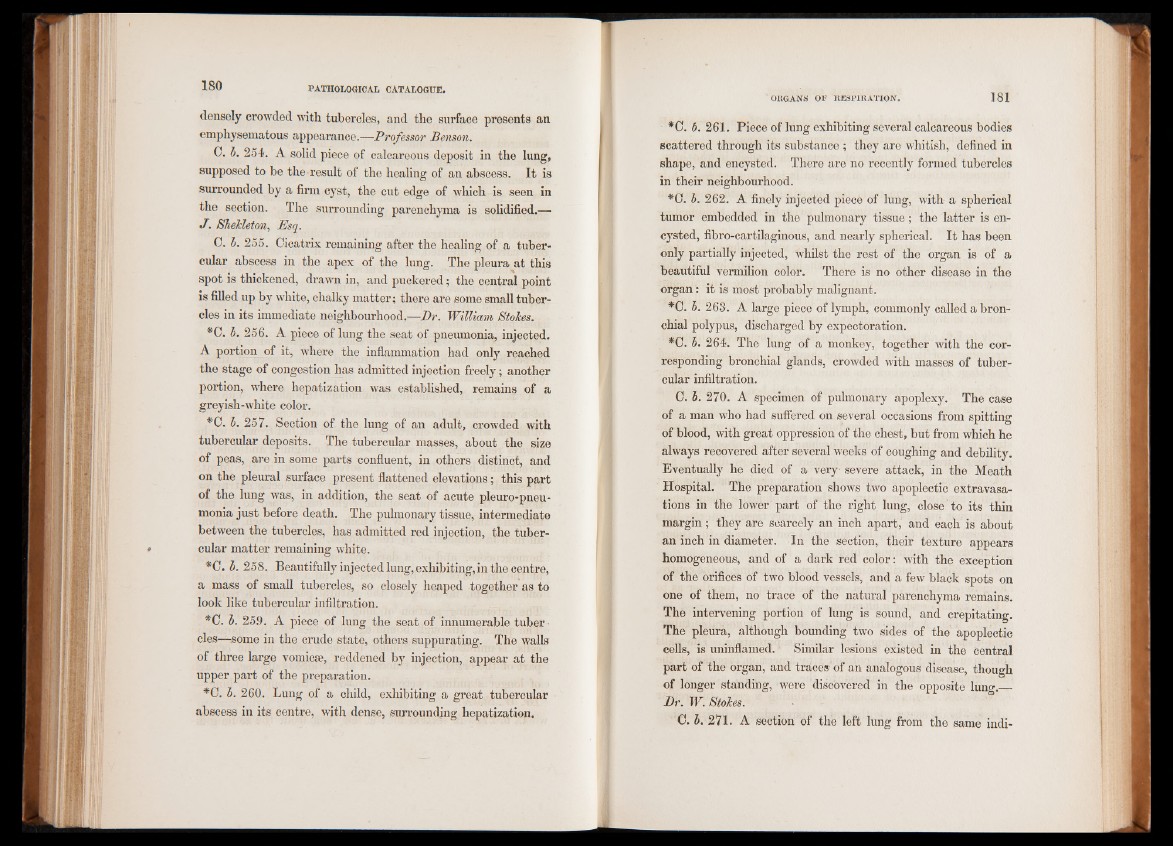
densely crowded with tubercles, and the surface presents an
emphysematous appearance.—Professor Benson.
C. b. 254. A solid piece of calcareous deposit in the lung,
supposed to be the result of the healing of an abscess. It is
surrounded by a firm cyst, the cut edge of which is seen in
the section. The surrounding parenchyma is solidified.—
J. Shekleton, Esq.
C. b. 255. Cicatrix remaining after the healing of a tubercular
abscess in the apex of the lung. The pleura at this
spot is thickened, drawn in, and puckered; the central point
is filled up by white, chalky matter; there are some small tubercles
in its immediate neighbourhood.—Dr. William Stokes.
*C. 1. 256. A piece of lung the seat of pneumonia, injected.
A portion of it, where the inflammation had only reached
the stage of congestion has admitted injection freely; another
portion, where hepatization was established, remains of a
greyish-white color.
*C. I- 257. Section of the lung of an adult, crowded with
tubercular deposits. The tubercular masses, about the size
of peas, are in some parts confluent, in others distinct, and
on the pleural surface present flattened elevations; this part
of the lung was, in addition, the seat of acute pleuro-pneu-
monia just before death. The pulmonary tissue, intermediate
between the tubercles, has admitted red injection, the tubercular
matter remaining white.
*C. b. 258. Beautifully injected lung, exhibiting, in the centre,
a mass of small tubercles, so closely heaped together as to
look like tubercular infiltration.
*C. b. 259. A piece of lung the seat of innumerable tuber
cles—some in the crude state, others suppurating. The walls
of three large vomicae, reddened by injection, appear at the
upper part of the preparation.
*0. b. 260. Lung of a child, exhibiting a great tubercular
abscess in its centre, with dense, surrounding hepatization.
ORGANS OF RESPIRATION. 181
*0. 6. 261. Piece of lung exhibiting several calcareous bodies
scattered through its substance ; they are whitish, defined in
shape, and encysted. There are no recently formed tubercles
in their neighbourhood.
*C. b. 262. A finely injected piece of lung, with a spherical
tumor embedded in the pulmonary tissue; the latter is encysted,
fibro-cartilaginous, and nearly spherical. It has been
only partially injected, whilst the rest of the organ is of a
beautiful vermilion color. There is no other disease in the
organ: it is most probably malignant.
*0. b. 263. A large piece of lymph, commonly called a bronchial
polypus, discharged by expectoration.
*0. b. 264. The lung of a monkey, together with the corresponding
bronchial glands, crowded with masses of tubercular
infiltration.
0. b. 270. A specimen of pulmonary apoplexy. The case
of a man who had suffered on several occasions from spitting
of blood, with great oppression of the chest, but from which he
always recovered after several weeks of coughing and debility.
Eventually he died of a very severe attack, in the Meath
Hospital. The preparation shows two apoplectic extravasations
in the lower part of the right lung, close to its t.bin
margin; they are scarcely an inch apart, and each is about
an inch in diameter. In the section, their texture appears
homogeneous, and of a dark red color: with the exception
of the orifices of two blood vessels, and a few black spots on
one of them, no trace of the natural parenchyma remains.
The intervening portion of lung is sound, and crepitating.
The pleura, although bounding two sides of the apoplectic
cells, is uninflamed. Similar lesions existed in the central
part of the organ, and traces of an analogous disease, though
of longer standing, were discovered in the opposite lung.__
Dr. W. Stokes.
0. b. 271. A section of the left lung from the same indi